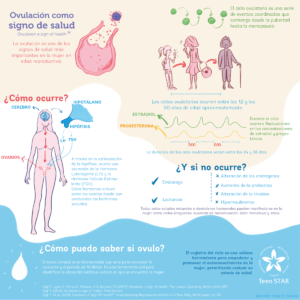Ovulation a sign of health ™
Ovulation a sign of health™
-Teen STAR Review-
Authors: Yanara A. Bernal, María Antonia Villablanca, Virginia de la Lastra.
Ovulation is among the most trustworthy signs of health in women of reproductive age. It is an indicator that allows to assess the hormonal and reproductive status of women. There are physiological conditions such as pregnancy or lactation, which produce an anovulatory state. This means an absence of ovulation, which can be part of the ovarian continuum. During puberty and perimenopause, it is expected to find irregular ovulatory cycles, since these are considered as transition periods. However, outside these normal situations, irregular ovulatory or anovulatory cycles can be signs of an unhealthy lifestyle or illness. Stress, endocrine, gynecological and genetic disorders, iatrogenic causes or the use of medications as hormonal contraceptives, can disrupt ovulation, often being the first sign of a hormonal disorder. However, despite the importance of this sign of health, women are unaware of the relevance of their ovulation and the impact it has on their daily lives. If women knew the real meaning of this sign, they could detect a lot of health problems earlier.
A series of complex structures interact with each other in order to achieve ovulation. The ovaries, together with the uterus and oviducts (uterine tubes or Fallopian tubes), are part of the internal female genitals. The ovaries are responsible for the production of sex hormones, estradiol and progesterone, and the development of follicles. A follicle is a structure formed by the oocyte (the germinal cell) surrounded by somatic cells (granulosa cells). According to their developmental stage, follicles can be classified as primordial, primary, secondary, tertiary, mature (Graafian), corpus luteum and Albicans.
The central nervous system (CNS) is a specialized structure that controls the functions related to motor, behavioral, cognitive and neuroendocrine coordination of the body. Hormones have an important effect upon the wiring of different brain areas, including the hypothalamus and pituitary gland. The CNS is regulated by hormonal feedbacks. The main structures of the CNS involved in the regulation of ovulation are the hypothalamus and pituitary gland. Kisspeptin, a neuropeptide recently identified is synthesized by neurons located in the hypothalamus. These group of neurons, known as the kisspeptinergic system, have significant relevance in the onset of puberty. They induce the secretion of GnRH, stimulating the production of gonadotropic hormones: Luteinizing Hormone (LH) and Follicle Stimulating Hormone (FSH). The gonadotropic hormones act upon the ovaries, where sex hormones are produced.
Women between 12 and 50 years of age normally exhibit regular ovulations characterized by 24 to 36 days cycles with fluctuating plasma estradiol and progesterone levels according to the different phases of the cycle. The first phase of the menstrual cycle is characterized by an increase in estradiol secretion by growing follicles. This phase starts with the first day of menstruation and lasts until ovulation. The luteal phase begins after ovulation and goes until the day before next menses. It is characterized by an increase in progesterone production by the corpus luteum.
The coordinated hormonal events required for ovulation are a) growth and development of an ovarian follicle and its oocyte, b) ovulation, c) preparation of the uterine lining (endometrium) to receive the zygote and d) endometrial lining detachment (menstruation), when fertilization does not occur.
At the beginning of each cycle, there is an increase in FSH levels that cause recruitment and development of antral follicles. FSH also triggers a progressive rise in estrogen production and secretion. After follicular recruitment, estradiol causes a decrease in FSH levels. A dominant follicle is selected, while the rest of the follicles degenerate. The dominant follicle produces increasingly higher levels of estradiol, which in turn stimulate kisspeptinergic neurons. Kisspeptin induces GnRH secretion and the pre-ovulatory LH peak, which initiates follicular luteinization leading to the formation of the corpus luteum. Before the initiation of the midcycle gonadotropin surge, a pre-ovulatory rise in progesterone occurs. This early progesterone rise produced by the pre-ovulatory follicle is critical for follicular rupture, a necessary process for ovulation. Progesterone maintains the LH peak causing follicular rupture, with the consequent release of the oocyte. The released oocyte will typically survive 12 to 24 hours. LH and progesterone contribute to the development and maintenance of the corpus luteum, which continues to produce progesterone and estrogen during the luteal phase. Normally this phase lasts for 11 to 16 days. If fertilization does not occur, the corpus luteum starts to regress. This regression causes a drop in estrogen and progesterone levels. The decrease in both hormones eliminates the suppression and a new cycle begins.
How to recognize ovulation?
Recognizing ovulation enables women and couples to identify the day when the probability of conception reaches its peak. With the signs given by the presence or absence of cervical mucus on the vulva, it is possible to identify the fertile window.
Cervical mucus undergoes several modifications during the phases of the reproductive cycle. Two main types of cervical mucus have been described: estrogenic and progestagenic. Increased estrogen levels halfway through the follicular phase result in a noticeable rise in the secretion of estrogenic mucus. The estrogenic cervical mucus is, transparent, fluid and crystalline, giving a slippery sensation in the vulva. During this period, cervical mucus allows sperm selection and ascent. Progesterone has the opposite effect of estradiol upon cervical mucus (antiestrogenic action). It inhibits production and changes the characteristics of the mucus to an opaque and less fluid mucus, with- out the ability to crystallize into palm leaf patterns.
The observation of changes in cervical mucus is considered a reliable biomarker as it has been demonstrated that recognizing mucus patterns can help women to identify the different stages of the ovarian continuum.
Endocrine abnormalities that can lead to ovulatory dysfunction are i) androgen disorders such as polycystic ovary syndrome, manifesting in women with acne, hirsutism, alopecia, increased body weight and mood changes; ii) increase in prolactin levels caused by stress, pituitary tumors, and some drugs. In these cases we can observe short luteal phases, anovulation, menstrual irregularities, amenorrhea, galactorrhea, skin dryness, immunological disorders, low libido, hot flashes, and sweaty hands; iii) thyroid disorders such as hypothyroidism which can lead to irregular menses, hypermenorrhea, metrorrhagia, and spotting, in addition to this, it is also associated with depressive symptoms, fatigue, lethargy, weight gain, cold intolerance and hair loss; iv) increase in insulin levels, caused by insulin resistance related in some occasion to obesity, weight gain, anovulation, menstrual irregularities, and amenorrhea.
All these disorders together with other alterations can manifest themselves through changes in woman’s cycles, either as menstrual irregularities, heavy bleeding, amenorrhea, menstrual pain, among others.
Often, healthcare providers have focused on regularizing bleeding patterns, without paying attention to ovulation in reproductive age women. Is important to consider ovulation as a sign of health and as the fundamental event of the women’s cycle.
For this reason, cycle charting is a valuable tool that empowers women, promoting self-knowledge and health care.
References
- Vigil P. et al. (2017): Ovulation, a sign of health. The Linacre Quarterly. 84(4): p343-355.
- Vigil P. (2019) Ovulation a sign of health. Third Edition.
- Vigil P. et al. (2019) Ovulation A Sign Of Health™: Understanding Reproductive Health In A New Way. White paper. p1-35.



